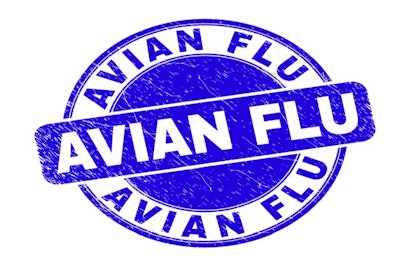
Among the countries reporting new outbreaks of highly pathogenic avian influenza (HPAI) in poultry are the Czech Republic, Denmark, Germany and Sweden. With ever more wild birds testing positive for the virus, most European states remain in high alert. However, there are signs of the disease situation easing in southwestern France.
This week, HPAI has been confirmed in a backyard flock in Zlin, reports Prague Daily Monitor. Twelve birds died out of the more than 400 geese, ducks and turkeys.
The latest cases brings to seven the number of regions in the country where outbreaks have been registered in poultry. No large commercial farms have so far been affected. However, 137,000 poultry were culled last year to control the further spread of infection. In addition, wild birds have tested positive for HPAI in five regions, including the capital Prague.
According to European Reference Lab for avian influenza IZSVe, the Czech authorities have confirmed 10 HPAI outbreaks in domestic poultry — all in backyard flocks, and involving the H5N8 virus variant. Up to the start of this month, this number stood at just three.
Spike in outbreaks among Danish poultry
Since the start of March, Danish Veterinary and Food Administration has registered five new HPAI outbreaks in poultry. These bring to 10 the number of outbreaks in Denmark since November of last year. The presence of the H5N8 virus variant has been detected at each location.
Among these latest outbreaks were two in commercial meat turkey flocks — a total of around 64,000 birds — in Lundby and Bogelunde in the municipality of Slagelse in Zealand. Previously, infections were confirmed in two backyard flocks (in Bornholm and Kalundborg), and in Ringsted at a farm rearing game birds. At the latter location, 94 of the 552 pheasants died.
The most recent outbreak was in another Zealand backyard flock comprising around 20 hens and ducks.
Sweden registers four new avian flu outbreaks in poultry
Over the past week, the Swedish Board of Agriculture has confirmed one earlier outbreak, and registered four more, all in the south of the country.
In Östergötland, outbreaks are reported in laying hens and a mixed poultry flock in Linköping. Another poultry flock and turkeys have become infected in the county of Skåne. A previously suspected outbreak in layers in Mjölby (Östergötland) has been confirmed.
IZSVe puts the number of HPAI outbreaks in Sweden so far at 15, a total that includes four linked to the H5N5 virus, and 11 to the H5N8 variant. A range of poultry and captive birds have been affected.
Germany registers new outbreaks in seven states
Since March 1, the number of detections of HPAI in Germany has risen by 304 to reach a total of 3,183, according to the national veterinary reference laboratory, Friedrich-Loeffler Institute.
Domestic poultry testing positive for HPAI virus have included turkeys, chickens, ducks, geese, laying hens and broiler breeders in seven different states. Around one-third of the new cases were turkeys in Lower Saxony.
In eight states, new cases have been revealed in wild birds. Several cases were confirmed among swans in Hessen.
Latest update from IZSVe puts the number of outbreaks of HPAI among German poultry at 107. All of these were linked to the H5N8 virus variant. Of the total, 49 outbreaks were among fattening turkeys, 25 in mixed poultry flocks, and 12 in laying hens.
Estonia remains on avian flu alert
HPAI has become widespread across northern Estonia, reports ERR News.
While the virus has been detected in wild birds in five counties, only one outbreak has so far been confirmed in poultry. In mid-February, the country’s first HPAI outbreak was confirmed in a backyard flock.
From the start of March, a housing order was put in place for all poultry across the country. Furthermore, ducks and geese are to be kept separate from chickens and turkeys.
Avian flu situation continues to ease in France, England
Based on information from the French agriculture ministry, the rapid spread of HPAI in southwestern poultry flocks has come almost to a halt.
Over the past week, the number of confirmed outbreaks has risen by just one – in the department of Pyrénées-Atlantiques, where the total now stands at 57. For this region, the number of confirmed outbreaks stands at 473. For the worst-affected departments — Landes (341 outbreaks) and Gers (64) — there has been no change.
In addition, France has recorded 13 HPAI outbreaks in poultry in other regions of France, and HPAI virus has been detected in 14 wild birds at various locations across the country. These figures are also unchanged from the previous week.
In the United Kingdom (U.K.), the agriculture department, Defra, reports that all movement restrictions related to Protection and Surveillance Zones have been lifted across England.
The latest to be eased were around a small commercial egg farm near Redcar in North Yorkshire, where an HPAI outbreak occurred one month ago. However, the Avian Influenza Prevention Zone remains in force across the whole of England. This requires all poultry to be kept housed away from wild birds.
H5N8 HPAI virus has been detected for the first time in seals and a fox. According to an official report to the World Organisation for Animal Health, these animals were from a wildlife rescue center in the U.K. where the deaths of wild birds had previously been linked to this virus. The virus from the infected mammals showed 99.9% similarity to that found in the infected wild birds.
The first evidence recently emerged from Russia that the same virus variant could infect humans.
View our continuing coverage of the global avian influenza situation.

















